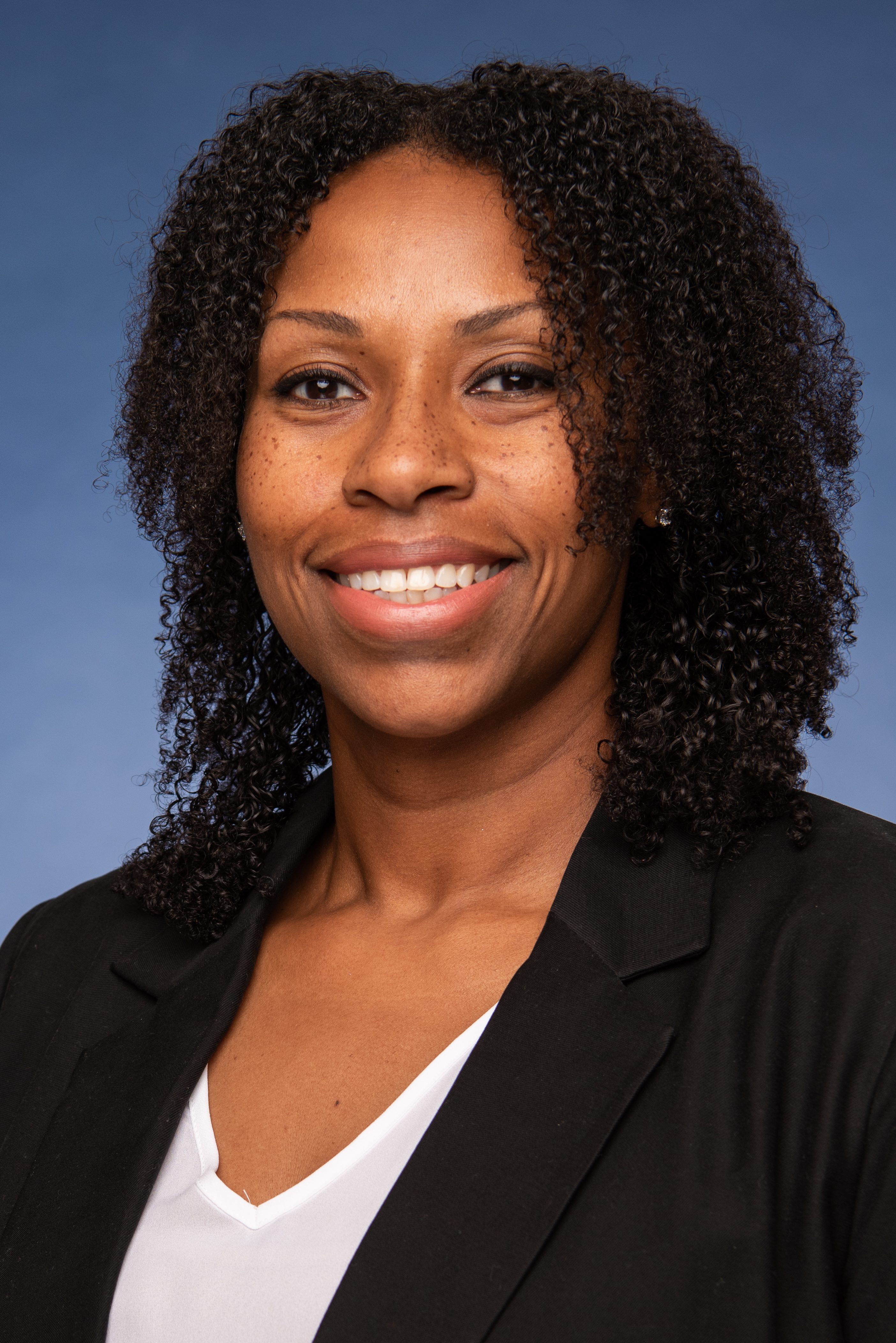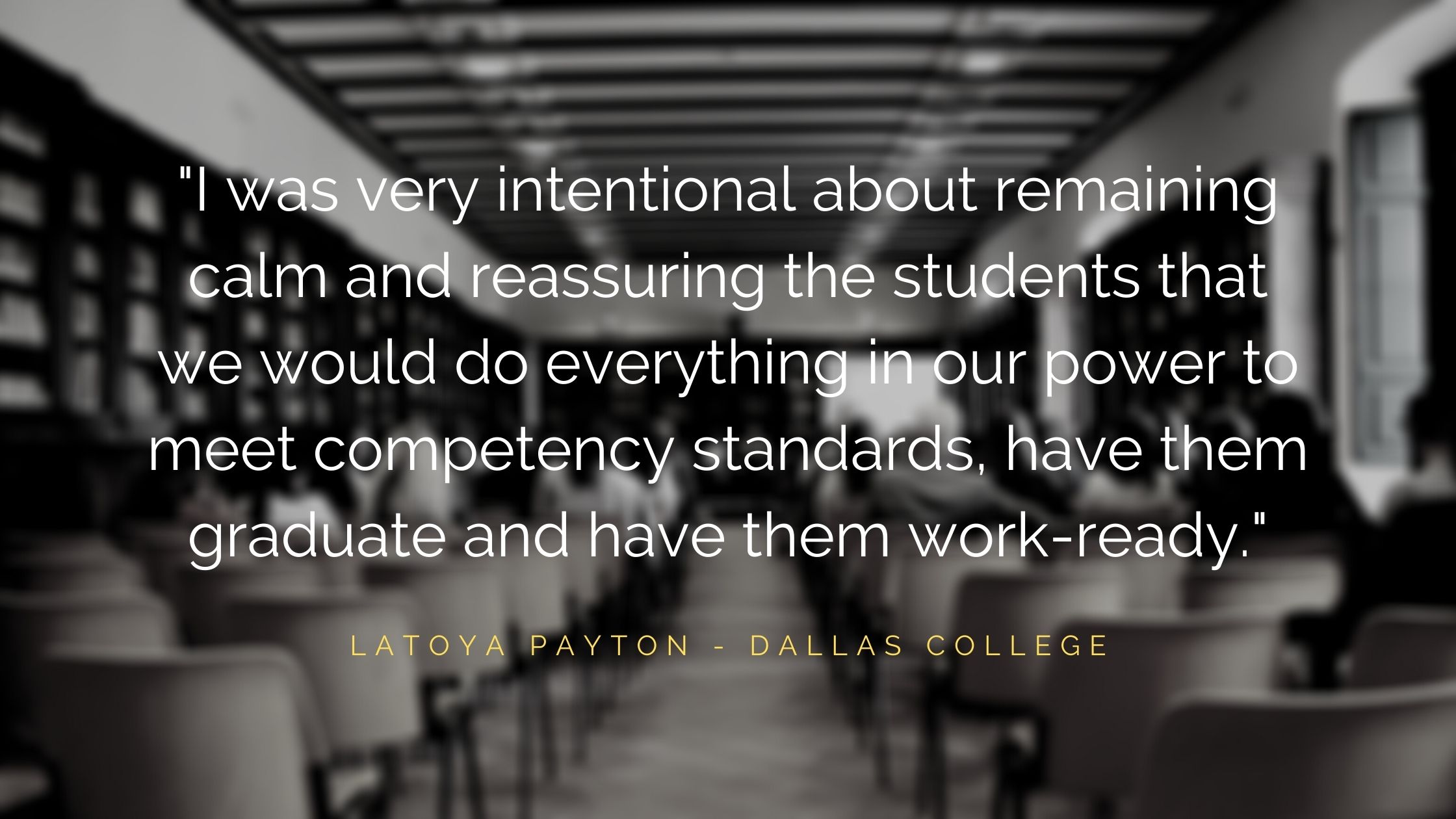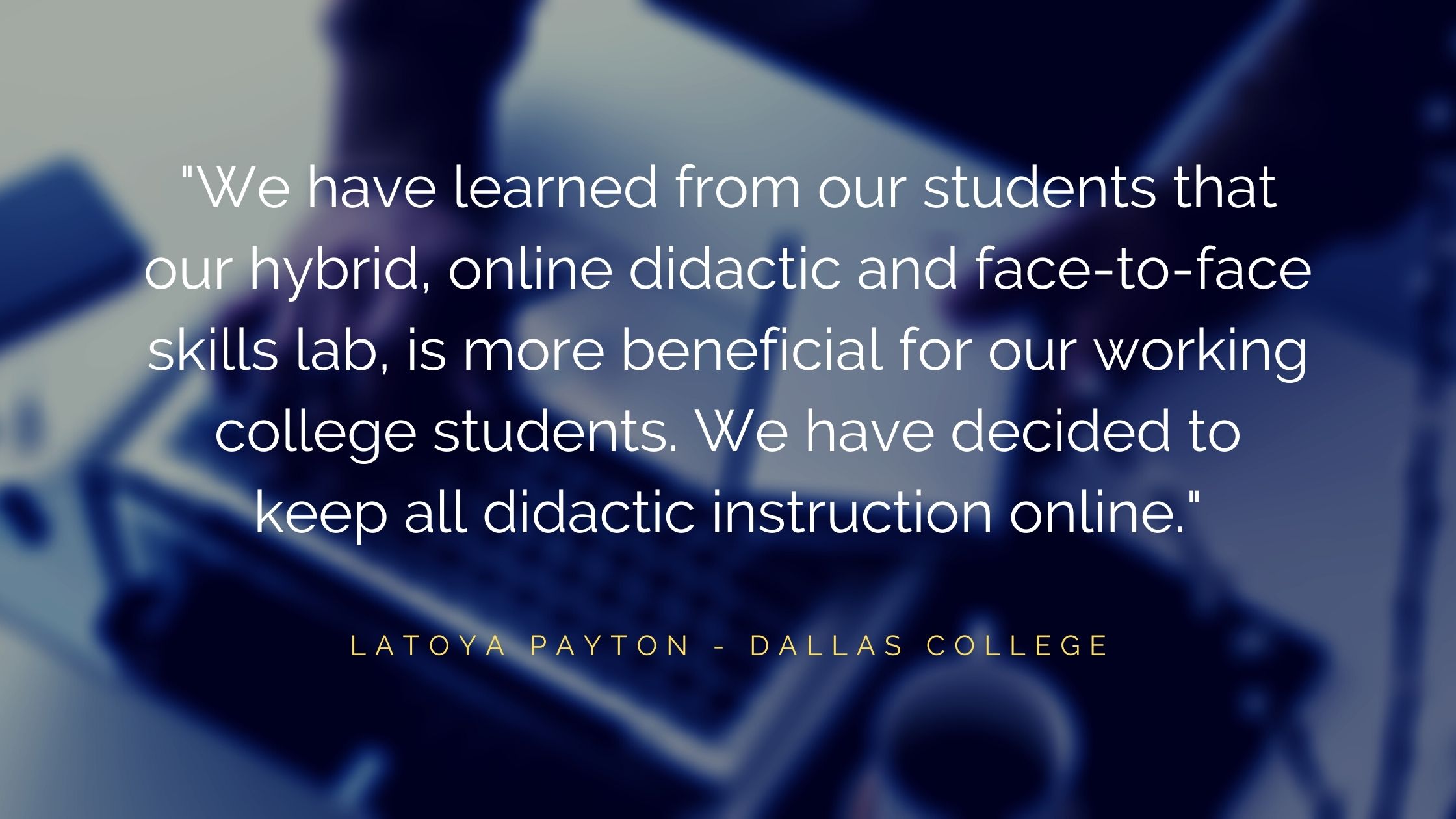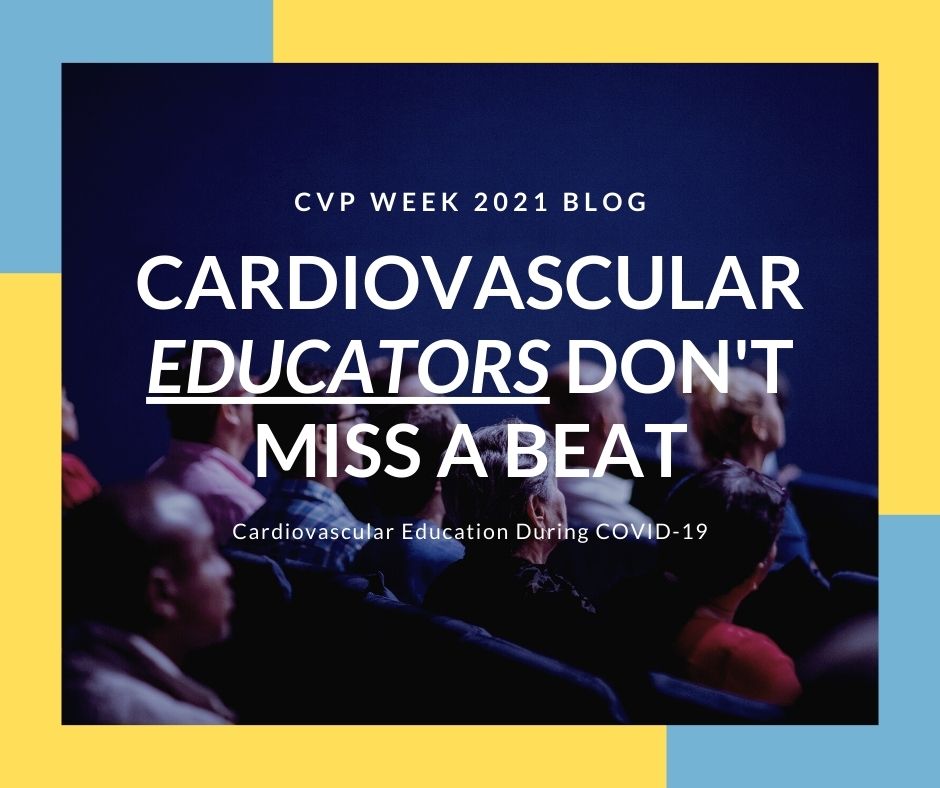
In celebration of Cardiovascular Professionals Week, we interviewed LaToya Payton, the Program & Clinical Coordinator for Dallas College’s School of Health Sciences, to understand what she and her colleagues at Dallas College have done over the past several months to continue delivering cardiovascular education during COVID-19.
Her responses perfectly illustrate our theme for CVP Week 2021—cardiovascular professionals (and educators!) don't miss a beat.
The Covid-19 pandemic has impacted the healthcare community in innumerable ways, from the “big picture” structure and function of our organizations, down to the minutiae of individual roles, responsibilities, and expectations within our institutions.
As we continue to conquer the hurdles set before us by COVID-19, taking note of what works and what doesn’t along the way, it is important that we consider the lessons and impact of the pandemic not only on our current practice, but in terms of how this period will inform our work in the years to come.
It is no surprise that in addition to care-delivering organizations, educational institutions have had an extremely difficult time adjusting to the pandemic, as physical distancing and other safety requirements have thrown a wrench into the scheduling of clinical learning opportunities, and the in-person instruction that is so critical to prepare the next generation of healthcare professionals.
LaToya Payton’s responses were instructive for a number of reasons, not least of which is that they emphasized the centrality of information-sharing as we continue our fight against the SARS-COV-2 virus, and the importance of taking a flexible, collaborative approach to our shared challenges and to cardiovascular education during COVID-19.
Interview: Cardiovascular Education during COVID-19
Below you can find a written record of our conversation with LaToya Payton, along with some additional notes and resources, which might be useful to professional educators, students, and also those currently working in the field.
We have taken the liberty of expounding on the topics, ideas, and potential solutions she points to for finding new ways to deliver necessary knowledge and pursue team-based collaboration amidst the pandemic. Our notes/resources are added in the bullet points below each of LaToya Payton’s answers.
What were your/Dallas College's initial reactions to the Covid-19 pandemic back in March? And what were the immediate actions taken at your organization to ensure student/faculty safety and prepare for the uncertainty ahead?
We were in the middle of spring break when the shutdowns began. The first thing college administration did was to prolong the break by an additional week. We were then informed that all face-to-face instruction, including clinical, were suspend until further notice and to find a suitable alternative to skills lab and clinical instruction. This proved to be very difficult as there aren't many, if any, virtual cath lab procedural simulations available online.
We decided to use videos of cath procedures on YouTube and case studies from our "Grossman & Baim's Cardiac Catheterization, Angiography, and Intervention" textbook. I also emailed some fellow invasive cardiovascular technology program directors to inquire how they were handling this new virtual learning situation. That email turned out to be blessing as it brought a very small community of educators together to support and info share different way to help our student successfully complete the semester.
My students received an incomplete grade for the clinical course for the Spring semester but were able to complete their missing clinical hours during the Summer semester. We were extremely blessed that many of our clinical partners allowed our students to return to complete their missing hours. We also delayed the intake of the new cohort by 1 semester.
- Flexibility—While YouTube videos are significantly different than in-person procedural observation, they can still provide actionable insight in terms of offering an accurate representation of both procedural requirements and the cath lab environment. Using these videos as additional resources and reference points for virtual classroom discussion could potentially allow instructors to assess student comprehension of procedural requirements, communication protocols among the cath team, and equipment-based knowledge.
- Collaboration—Convening a “community of educators” and sharing resources, ideas, and innovative approaches to classroom instruction is a phenomenal idea that should be carried with us into the post-Covid-19 period. While institutions of higher learning often see one another as “competitors” in a more traditional environment, the barriers that have been brought down by the pandemic reinforce the shared mission of all educational institutions.
- Rescheduling—Delaying the intake of the new student cohort allowed for Dallas College to further hone their approach and protocols for teaching students in a virtual environment. Sometimes taking time away from work to readjust, evaluate your efforts, and generate consensus around “next steps” is a necessary aspect of contingency planning, though it may be frustrating at times.

In terms of organizational communication -- Did you receive any initial responses or feedback from students? And were you intentional about the tone of your communications to students? If so, what was your tone/intent?
Yes, I am very honest with my students and have an open-door policy. My students were very open with their needs and concerns. We were all concerned and uncertain as to how thing were going to pan out. That cohort of students were due to graduate and challenge the RCIS exam at the end of the semester, but due to COVID-19, testing had stopped indefinitely.
I shared information I gathered regarding testing and clinical availability in attempts to calm anxieties. I was very intentional about remaining calm and reassuring the students that we would do everything in our power to meet competency standards, have them graduate and have them "work ready".
- Calmness—It is easy during periods of crisis to feel overwhelmed, and uncertainty is an intimidating factor to contend with, especially when the wellbeing and success of others is on the line. The essential task of leadership is to balance their emotional understanding of student reactions with an honest, rational approach to the problems both faculty and students face. Ultimately, the relationships – of students and other students, between students and instructors, and among faculty coworkers – sit at the center of educational pursuits.
What were the initial concerns of staff/faculty, and how were they addressed?
Our biggest concerns were completing clinical hours, technical skill proficiency, and when they would be able to challenge the RCIS exam. Our clinical partners were amazing and allowed our students to return to complete missing hours, we used procedure videos and video conference software to assess skill proficiency, and CCI and Pearson reopened some of their testing centers which helped our students earn their credentialing.
- Relationships—Again, LaToya’s response underscores the importance of relationships for accomplishing mutual goals. The inclusion of clinical partners in the forward planning of Dallas College facilitated a smoother return to essential clinical education.
How did you start phasing back into a more "normal" routine, and what did this new normalcy look like?
We kept didactic instruction online. We had to receive approval for face-to-face instruction and were only allowed on campus for that time period. No office time, no hanging out on campus. They closed the student common areas and on-campus food services. Our students and faculty must sign into a COVID-19 screening tool when visiting campus or clinical.
Regarding clinical education -- What changes have taken place regarding students' clinical engagement?
Our students are no longer allowed to be in the procedure room during intubations and are not allowed to participate in the care of known COVID-19 patients. Students and faculty were required to perform a symptom self-assessment prior to coming to campus and clinical.
- Self-Directed Learning—In addition to being a necessary safety protocol, the performance of symptom self-assessments is an opportunity to reinforce clinical learning. Using the real-world, lived experience to reinforce educational topics is an opportunity that should not be overlooked.

What are the biggest lessons you've learned from March until now? And is there anything that you think will "stick" (in terms of systems, policies, attitudes/beliefs, etc.) in the post-Covid period?
We have learned from our students that our hybrid, online didactic and face-to-face skills lab, is more beneficial for our working college students. We have decided to keep all didactic instruction online. Also, we will continue to Fit Test all our students.
- Educational Access—The ability to provide education in a more accessible manner will only improve the healthcare workforce of the future, by increasing the diversity of the workforce as well as by providing a more supportive learning environment which is cognizant of the needs of individual students. This is a lesson from Covid-19, which we should absolutely consider going forward beyond the pandemic: How can we bring education to as many potential healthcare professionals as possible in the years to come?
Have you developed any new partnerships throughout the pandemic -- with employers, hospitals, other educational institutions and the like?
I must say that the community of cardiovascular educators has been a great support system throughout the pandemic. The educator community had two virtual conferences which provided support and ideas on how to successfully navigate through the pandemic. The flexibility and availability of our clinical partners has really a tremendous help!
Reflecting on your experience so far, if you could give a single piece of advice to other program/clinical/education coordinators, what would it be?
Do not be afraid to ask for help! Chances are someone is going through or has gone through what you are going through. Get connected with our cardiovascular educator community by attending the CCI educators conference. It was a tremendous help to me as a new program director as well as during the pandemic.
- Find your Educational Community—It can’t be said enough, healthcare is a collaborative pursuit, from the education of new professionals to the direct-care delivered at the patient point-of-contact. Finding a community of supportive peers is not only extremely helpful from the perspective of an individual’s experience, but it is absolutely essential to continue improving the quality of our services for the years to come. (Small plug… Professional societies like The Alliance of Cardiovascular Professionals exist to connect you to peers, opportunities for learning and professional growth, and ultimately make sure you are the best you can be. We are here to support you! J)
Who supports YOU in your ongoing work and the changes that have taken place? And how do you think you're faring personally throughout COVID?
My patient and loving family! They support me, listen to me vent, scream, cry and cheer me on when I have successes. Also, I lucked out and have the best Dean in the world! His door is always open, gives sage advice and is a big advocate for our small program.
Personally, in the beginning I was like most people and was fearful of all the unknowns and uncertainties. The quarantining wasn't too bad as I am a homebody anyway and teaching/working and my husband also working from home made it possible for my 1st grade daughter to participate virtual schooling. We have adjusted very well and I'm just blessed that I have been able to continue to serve my students and help them reach their educational goals.
ACVP extends our heartfelt thanks to LaToya Payton for taking time out of her day to share her experience and insight. And to all the students and staff at Dallas College and the many other educational institutions working to keep our future professionals prepared for the many obstacles ahead, Thank You. Ultimately, our successes, future lessons, and next steps forward are grounded in your efforts, and we at the Alliance of Cardiovascular Professionals can’t say enough how grateful we are for all that you do.
